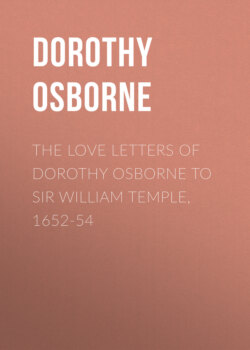Читать книгу The Love Letters of Dorothy Osborne to Sir William Temple, 1652-54 - Dorothy Osborne - Страница 6
EARLY LETTERS. WINTER AND SPRING 1652–53
ОглавлениеThis first chapter begins with a long letter, dated from Chicksands some time in the autumn of 1652, when Temple has returned to England after a long absence. It takes us up to March 1653, about the end of which time Dorothy went to London and met Temple again. The engagement she mentions must have been one that her parents were forcing upon her, and it was not until the London visit, I fancy, that her friendship progressed beyond its original limits; but in this matter the reader of Dorothy's letters will be as well able to judge as myself.
Letter I.—Goring House, where Dorothy and Temple had last parted, was in 1646 appointed by the House of Commons for the reception of the French Ambassador. In 1665 it was the town house of Mr. Secretary Bennet, afterwards Lord Arlington. Its grounds stood much in the position of the present Arlington Street, and Evelyn speaks of it as an ill-built house, but capable of being made a pretty villa.
Dorothy mentions, among other things, that she has been "drinking the waters," though she does not say at what place. It would be either at Barnet, Epsom, or Tunbridge, all of which places are mentioned by contemporary letter-writers as health resorts. At Barnet there was a calcareous spring with a small portion of sea salt in it, which, as we may gather from a later letter, had been but recently discovered. This spring was afterwards, in the year 1677, endowed by one John Owen, who left the sum of £1 to keep the well in repair "as long as it should be of service to the parish." Towards the end of last century, Lyson mentions that the well was in decay and little used. One wonders what has become of John Owen's legacy. The Epsom spring had been discovered earlier in the century. It was the first of its kind found in England. The town was already a place of fashionable resort on account of its mineral waters; they are mentioned as of European celebrity; and as early as 1609 a ball-room was erected, avenues were planted, and neither Bath nor Tunbridge could rival Epsom in the splendour of their appointments. Towards the beginning of the last century, however, the waters gradually lost their reputation. Tunbridge Wells, the last of the three watering-places that Dorothy may have visited, is still flourishing and fashionable. Its springs are said to have been discovered by Lord North in 1606; and the fortunes of the place were firmly established by a visit paid to the springs by Queen Henrietta Maria, acting under medical advice, in 1630, shortly after the birth of Prince Charles. At this date there was no adequate accommodation for the royal party, and Her Majesty had to live in tents on the banks of the spring. An interesting account of the early legends and gradual growth of Tunbridge Wells is to be found in a guide-book of 1768, edited by one Mr. J. Sprange.
The elderly man who proposed to Dorothy was Sir Justinian Isham, Bart., of Lamport in Northamptonshire. He himself was about forty-two years of age at this time, and had lost his first wife (by whom he had four daughters) in 1638. The Rev. W. Betham, with that optimism which is characteristic of compilers of peerages, thinks "that he was esteemed one of the most accomplished persons of the time, being a gentleman, not only of fine learning, but famed for his piety and exemplary life." Dorothy thinks otherwise, and writes of him as "the vainest, impertinent, self-conceited, learned coxcomb that ever yet I saw." Peerages in Dorothy's style would perhaps be unprofitable writing. The "Emperor," as Dorothy calls him in writing to Temple, may feel thankful that his epitaph was in others hands than hers. He appears to have proposed to her more than once, and evidently had her brother's good offices, which I fear were not much in his favour with Dorothy. He ultimately married the daughter of Thomas Lord Leigh of Stoneleigh, some time in the following year.
Sir Thomas Osborne, a Yorkshire baronet, afterwards Earl of Danby, is a name not unknown in history. He was a cousin of Dorothy; his mother, Elizabeth Danvers, being Dorothy's aunt. He afterwards married Lady Bridget Lindsay, the Earl of Lindsay's daughter, and the marriage is mentioned in due course, with Dorothy's comments. His leadership of the "Country Party," when the reins of government were taken from the discredited Cabal, is not matter for these pages, neither are we much concerned to know that he was greedy of wealth and honours, corrupt himself, and a corrupter of others. This is the conventional character of all statesmen of all dates and in all ages, reflected in the mirror of envious opposition; no one believes the description to be true. Judged by the moral standard of his contemporaries, he seems to have been at least of average height. How near was Dorothy to the high places of the State when this man and Henry Cromwell were among her suitors! Had she been an ambitious woman, illustrious historians would have striven to do justice to her character in brilliant periods, and there would be no need at this day for her to claim her place among the celebrated women of England.
